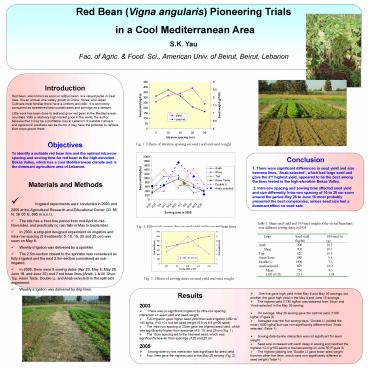Red Bean (Vigna angularis) Pioneering Trials PowerPoint PPT Presentation
1 / 1
Title: Red Bean (Vigna angularis) Pioneering Trials
1
Red Bean (Vigna angularis) Pioneering Trials in
a Cool Mediterranean Area S.K. Yau Fac. of
Agric. Food. Sci., American Univ. of Beirut,
Beirut, Lebanon
Introduction Red bean, also known as azuki or
adzuki bean, is a valued pulse in East Asia. It
is an annual vine widely grown in China, Korea,
and Japan. Cultivars most familiar there have a
uniform red color. It is commonly consumed as
sweetened bean paste/cakes and porridge as a
dessert. Little work has been done to test and
grow red bean in the Mediterranean countries.
With a relatively high market price in the world,
the author believes that it may be a profitable
crop in Lebanon. If suitable cultivars and
agronomic practices can be found, it may have the
potential to replace illicit crops grown there.
Objectives To identify a suitable red bean
line and the optimal intra-row spacing and sowing
time for red bean in the high-elevation Bekaa
Valley, which has a cool Mediterranean climate
and is the dominant agriculture area of Lebanon.
Fig. 1. Effects of intrarow spacing on seed yield
and seed weight
Conclusion 1. There were significant differences
in seed yield and size between lines.
Anab-selected, which had large seed and gave
the 2nd highest yield, appeared to be the best
among the lines tested in the high-elevation
Bekaa Valley. 2. Intra-row spacing and sowing
time affected seed yield and size differently.
Intra-row spacing of 10 to 20 cm sown around the
period May 26 to June 16 most probably presented
the best compromise, unless seed size had a
dominant effect on seed sale.
Materials and Methods ü Irrigated
experiments were conducted in 2003 and 2005 at
the Agricultural Research and Educational Center
(3356 N, 3605 E, 995 m a.s.l.). ü The
site has a frost-free period from mid-April to
mid-November, and practically no rain falls in
May to September. ü In 2003, a strip-plot
designed experiment on irrigation and intra-row
spacing (5 treatments 5, 10, 15, 20 and 25 cm)
was sown on May 8. ü Weekly irrigation was
delivered by a sprinkler. ü The
2.5m-section closest to the sprinkler was
considered as fully irrigated and the next
2.5m-section considered as sub-irrigated. ü
In 2005, there were 5 sowing dates (Apr 20, May
6, May 26, June 16, and June 30) and 7 red bean
lines (Anab, L W, Shun, Top, Asian Taste,
Double Li, and Anab-selected) in the split-plot
experiment. ü Weekly irrigation was
delivered by drip-lines.
Fig. 2. Effects of sowing date on seed yield of
the six red bean lines
Fig. 3. Effects of sowing dates on seed yield and
seed weight
Ø One line gave high yield in the May 6 and
May 26 sowings, but another line gave high yield
in the May 6 and June 16 sowings. Ø The
highest yield (1740 kg/ha) was obtained from
Shun and Anab-selected in the May 26 sowing.
Ø On average, May 26 sowing gave the
optimal yield (1180 kg/ha) (Figure 3). Ø
Averaged over the five sowing days, Double Li
yielded the most (1000 kg/ha) but was
non-significantly different from Anab-selected
(Table 1). Ø Sowing-date-by-line
interaction was not significant for seed weight.
Ø Seed size increased with each delay in
sowing and reached the highest (12.0 g/100 seed)
in the last sowing on June 30 (Figure 3). Ø
The highest yielding line Double Li gave lower
seed weight than the other five lines, which were
non-significantly different in seed weight (Table
1).
Results 2003 Ø There was no significant
irrigation by intra-row spacing interaction on
seed yield and seed weight. Ø
Full-irrigation gave higher seed yield than
sub-irrigation (480 vs 140 kg/ha, Plt0.10), but
not seed weight (6.8 vs 8.8 g/100 seed). Ø
The intra-row spacing of 20cm gave the highest
seed yield, which was significantly higher than
spacings of 5, 10, and 25 cm (Fig. 1). Ø
The 10cm spacing led to the heaviest seed, which
was significantly heavier than spacings of 20 and
25 cm. 2005 Ø Sowing-date-by-line
interaction was significant for seed yield.
Ø Four lines gave the highest yield in the
May 26 sowing (Fig. 2).

